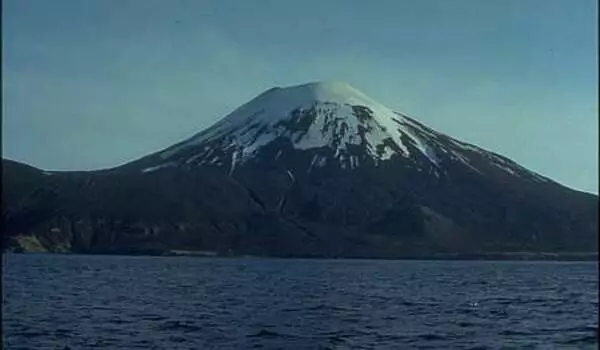According to new research from the Alaska Volcano Observatory, magma beneath the long-dormant Mount Edgecumbe volcano in Southeast Alaska has been moving upward through the Earth’s crust. The observatory’s new approach could lead to earlier detection of volcanic unrest in Alaska.
Computer modeling based on satellite imagery shows magma rising to about 6 miles from a depth of about 12 miles at Mount Edgecumbe, causing earthquakes and significant surface deformation.
“That is the fastest rate of volcanic deformation that we currently have in Alaska,” said Ronni Grapenthin, an associate professor of geodesy at the University of Alaska Fairbanks. “And, while deformation of volcanoes is not uncommon,” he said, “the activity at Edgecumbe is unusual because reactivation of dormant volcanic systems is rarely observed.”
Grapenthin believes an eruption is unlikely.
We’ve done these kinds of analyses before, but new streamlined cloud-based workflows cut weeks or months of analysis down to just days.
David Fee
Researchers from the University of Alaska Geophysical Institute and the United States Geological Survey published their findings in the journal Geophysical Research Letters. The Alaska Volcano Observatory collaborated with another Geophysical Institute unit, the Alaska Satellite Facility, to process data in the cloud, a first for the volcano team.
Cloud computing uses remote servers to store data and provide computing services, eliminating the need for a researcher to download and sort data, which can take weeks or months.
On April 11, 2022, a swarm of earthquakes was detected at Mount Edgecumbe, prompting the research team to get to work. The researchers examined ground deformation detected in satellite radar data over the previous 7 1/2 years.
Four days later, on April 15, the team had a preliminary result: An intrusion of new magma was causing the earthquakes. A small number of earthquakes began under Edgecumbe in 2020, but the cause was ambiguous until the deformation results were produced.

Additional data processing confirmed the preliminary finding. The Alaska Volcano Observatory informed the public on April 22, less than two weeks after the latest batch of Edgecumbe earthquakes was reported.
“We’ve done these kinds of analyses before, but new streamlined cloud-based workflows cut weeks or months of analysis down to just days,” said David Fee, the Alaska Volcano Observatory’s coordinating scientist at the Geophysical Institute.
Mount Edgecumbe, at 3,200 feet, is on Kruzof Island on the west side of Sitka Sound. It is part of the Mount Edgecumbe Volcanic Field, which includes the domes and craters of adjacent Crater Ridge.
Most striking for the researchers was an area of ground uplift on southern Kruzof Island 10.5 miles in diameter and centered 1.5 miles east of the volcano. The upward deformation began abruptly in August 2018 and continued at a rate of 3.4 inches annually, for a total of 10.6 inches through early 2022.
Following computer modeling, it was determined that the cause was the intrusion of new magma. Because ground deformation is one of the earliest indicators of volcanic unrest, new deformation-based analysis will allow for earlier detection. Because deformation can occur without accompanying seismic activity, ground uplift is an important symptom to monitor.
The new approach is being used by the volcano observatory on other volcanoes in Alaska, including Trident Volcano, which is located about 30 miles north of Katmai Bay. The volcano is displaying signs of increased unrest.
Grapenthin believes Mount Edgecumbe is not on the verge of erupting. “This magma intrusion has been going on for three or more years,” he explained. “We expect more signs of unrest prior to an eruption: more seismicity, more deformation, and, most importantly, changes in seismicity and deformation patterns.”
The magma is most likely reaching an upper chamber via a near-vertical conduit, according to the researchers. They also believe that thick magma in the upper chamber prevents the magma from moving further upward. Instead, the new magma is pushing the entire surface upward. Mount Edgecumbe is located 15 miles west of Sitka, which has a population of approximately 8,500 people.
According to Herman Kitka’s Lingt oral history, the volcano last erupted 800 to 900 years ago. According to the account, a group of Tlingits in four canoes camped on the coast about 15 or 20 miles south of some large smoke plumes. A scouting party in a canoe was sent to investigate the smoke and reported “a mountain blinking, spouting fire and smoke.”
















